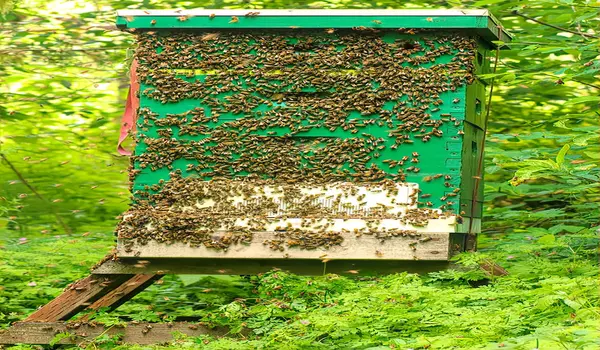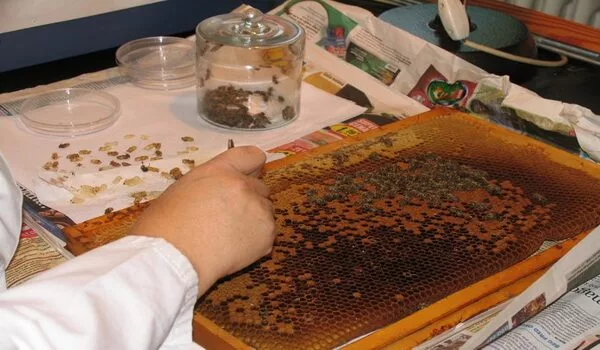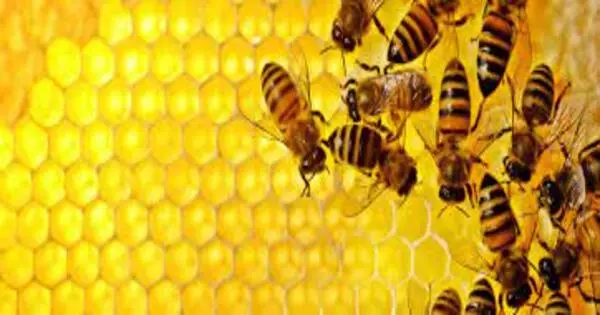Professor Ivan Toplak of the University of Ljubljana’s Veterinary Faculty explains what we know about honeybee virul strains and how they spread between colonies.
Virus infections are a major hazard to honeybee beekeeping around the world, and viruses are regularly found not only in weak or destroyed bee colonies, but also in clinically healthy bees. As a result, deciphering honeybee viral infections in tested honeybee colonies or apiaries might be difficult. The phylogenetic comparison of honeybee viral infection strains can be a useful tool for understanding transmission not just across honeybee colonies but also to other pollinators, as evidenced by some research investigations based on nucleotide comparison of sequenced partial or entire viral genomes. The same method is currently being used to inhibit and monitor the spread of several animal and human infections. Because bee viruses do not infect people, bee products do not represent a health risk.
Viruses that infect honeybees come in a variety of species.
More than 30 different species of honeybee viruses have been identified, with about half of them discovered in the last several decades. Most of these have yet to be determined if they cause actual damage to infected bee families or what the symptoms of illness are. The phylogenetic analysis of honeybee virus and varroa mite (Varroa destructor) positive samples revealed that both species had almost identical strains of various honeybee viruses, indicating that varroa is an efficient carrier between honeybee colonies and apiaries.
Varroa as a viral vector for bees
Varroa (Varroa destructor) infestations began in Europe about 50 years ago, and this profoundly altered the understanding of the pathogenesis of viral infections in honeybees. Viruses of many sorts can be transferred during varroa infestations on brood and bees. Not only is varroa the vector for individual viruses that, when injected directly into the bee while sucking fat bodies, can have major effects on infected bees due to the low infective dose and rapid virus replication. Controlling varroa infestation at a low level in the apiary is thus the most important preventive action beekeepers can take to reduce the impact of viral infections on bee colonies.

Evolutionary adaptability and viral loads
Honeybee viruses can be detected in a higher viral load and varroa infestation, producing brood death, varying degrees of clinical signs in worker bees, and premature bee deaths in some cases, while in other cases, honeybee viruses can be detected in a lower viral load and not cause clinical signs of disease. All of these can cause a bee colony’s weakening, which can lead to the colony’s final collapse.
Slovenian honeybee strains
When compared to strains detected in honeybee samples collected in Slovenia, genetically identical strains of black queen cell virus (BQCV), acute bee paralysis virus (ABPV), sacbrood bee virus (SBV), and Lake Sinai virus (LSV) were recently identified in bumblebee positive samples. This confirmed that some endemic strains of honeybee viruses infect bumblebees and vice versa. Furthermore, this study found that endemic strains of BQCV, ABPV, SBV, and LSV have a significant level of genetic diversity. This is remarkable given that Slovenia is a small country in Central Europe with a limited geographical area. Several phylogenetic studies of bee viruses circulating among Carniolan honeybees (Apis mellifera carnica), which are protected by national law in Slovenia, have confirmed the presence of high genetic heterogeneity among strains, confirming that the indigenous bee breed is not completely isolated from other European bees, despite the prohibition on legal bee importation.
Sequencing is used to identify honeybee strains.
Little is known about which strains of bee viruses are also found in other insect species and what role they play in virus transmission and maintenance in a bee population. Increased use of rapid Sanger sequencing from PCR products and next generation sequencing (NGS) technology on bee samples will almost certainly lead to the identification of new circulating strains and types of bee viruses in the future, which have not yet been identified, thus improving knowledge of viral infections in bees.

Identifying individual virus strains
With an increasing number of sequenced positive samples containing one or more honeybee strains from the same geographic area and different countries around the world, as well as a growing number of sequences deposited into GenBank, it is possible to provide more detailed and comprehensive phylogenetic studies with a presentation of the genetic relationship between detected viral strains in honeybees, varroa, and other pollinators. The phylogenetic comparison of sequenced positive samples offers a good opportunity for tracing individual viral strains’ transmission between colonies on a local and global scale, studying virus evolution and the epidemiological adaptation of different strains to new circumstances, which can be observed in practice but are still poorly understood for many years.
More research on virus transmission is required.
We would better understand the different clinical manifestations of viral diseases and evolutionary processes that occur when new relationships between different strains of viruses, varroa, and bees are established if we knew the way and frequencies of the transmission of individual types of viruses within varroa-infested and varroa-free honeybee colonies, apiaries, and between apiaries. It is hard to grasp a more complicated system of clinical indications of viral infections and means of enduring a virus infection in bee populations without extensive knowledge of the mechanisms and frequency of virus transmission at the level of individual bees and within the honeybee colony. Despite existing knowledge of basic principles and considerable scientific advances in recent years, much virus research based on strain sequencing and virus transmission must be done to increase honeybee colony survival in the future.





